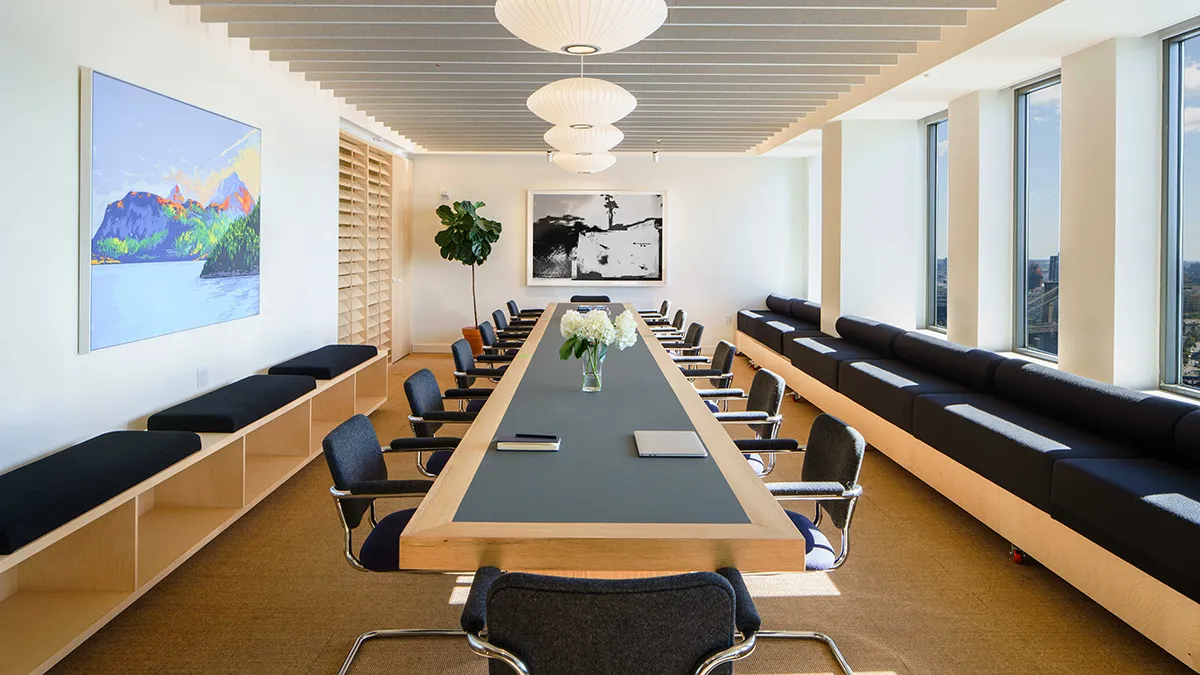LIFESTYLE
Boardrooms: Features and Ideal Use Cases

Boardrooms serve as the center for high-level decision-making in businesses. These spaces are designed to support discussions, negotiations, and strategic planning. A well-equipped boardroom enhances productivity and ensures smooth communication among key stakeholders. Understanding the essential features of a boardroom and how they are best used helps businesses make the most of their meeting spaces.
Key Features of a Boardroom
Technology for Communication and Collaboration
A boardroom must have the right tools to enable smooth discussions. High-quality video conferencing systems are essential for companies with teams spread across different locations. Clear audio systems and large display screens ensure that everyone can participate without disruption. Interactive whiteboards and digital presentation tools allow presenters to share ideas effectively. Reliable internet connectivity is a must to keep virtual meetings seamless.
Comfortable and Professional Seating
Seating arrangements in a boardroom affect engagement and focus. Chairs should provide adequate support for long meetings. The layout must allow all participants to maintain eye contact and contribute to discussions. A round or rectangular table with comfortable spacing ensures that attendees can communicate without barriers. The right seating setup encourages participation and collaboration.
Soundproofing for Privacy
Meetings held in a boardroom or meeting rooms in India often involve sensitive discussions. Soundproofing keeps conversations confidential and prevents external noise from disrupting the meeting. Acoustic panels, insulated walls, and solid-core doors contribute to sound control. A quiet environment helps participants focus and ensures that discussions remain undisrupted.
Lighting and Ambience
Proper lighting impacts attention and energy levels in meetings. A boardroom should have a balance between natural and artificial light. Adjustable lighting allows the brightness to be changed based on the nature of the meeting. Soft lighting can be used for discussions, while brighter settings work better for presentations. The ambiance should create a professional setting without feeling too rigid.
Adequate Space for Mobility
A boardroom should have enough space for movement. Attendees should be able to enter and exit without interrupting discussions. There must be room for additional materials like flip charts, projectors, and presentation boards. A clutter-free environment makes meetings more productive and keeps distractions minimal.
Temperature Control for Comfort
Room temperature affects concentration levels. A boardroom should have an adjustable thermostat to maintain a comfortable setting. Poor ventilation or extreme temperatures can reduce focus and impact meeting outcomes. An efficient climate control system ensures that participants remain engaged without distractions.
Ideal Use Cases for Boardrooms
High-Level Business Meetings
Boardrooms are the preferred setting for leadership meetings. These spaces allow executives to discuss business strategies, review financial reports, and plan future initiatives. The controlled environment ensures privacy and professionalism, making it the right choice for crucial decision-making.
Client Presentations and Pitches
Businesses use boardrooms to conduct important client meetings. A well-designed space leaves a strong impression on potential partners and investors. Presentations held in a boardroom setting appear more formal and structured. The presence of advanced technology supports multimedia presentations, making it easier to convey ideas effectively.
Strategy and Planning Sessions
Strategic discussions require an environment free from distractions. Boardrooms provide the perfect space for brainstorming sessions and long-term planning. Whiteboards, projectors, and digital tools support the process, allowing teams to map out objectives and key milestones.
Training and Workshops
Companies often conduct leadership training and executive workshops in boardrooms. The structured setting ensures a professional learning environment. Training sessions that require hands-on participation benefit from an organized space equipped with screens and presentation tools.
Negotiations and Contract Discussions
Sensitive discussions such as contract negotiations require a private and secure space. A boardroom offers confidentiality, allowing businesses to discuss deals without outside interference. The formal setting also ensures that all parties remain focused and engaged in the discussion.
Conclusion
Boardrooms are more than just meeting spaces. Their design, features, and functionality make them essential for businesses to conduct important discussions. Whether used for strategy planning, client meetings, or negotiations, a well-equipped boardroom enhances collaboration and decision-making. Businesses that invest in a well-structured boardroom ensure that their meetings are productive and professional.
LIFESTYLE
Mikki Mase Net Worth: The King of Baccarat’s Casino Journey

Step into the world of high stakes and glamour as we delve into the captivating journey of Mikki Mase Net Worth, known as the King of Baccarat in the thrilling realm of casinos. From humble beginnings to amassing a fortune through his unparalleled skills in the game, Mikki Mase’s story is one that exudes charisma, ambition, and a touch of controversy. Join us on this exhilarating ride as we uncover the intriguing details behind Mikki Mase Net Worthand his legendary status in the casino industry.
Early Life and Career Beginnings in the Casino Industry
Mikki Mase Net Worth journey into the world of casinos started with humble beginnings. Growing up in a modest neighborhood, he discovered his love for card games at a young age. Despite facing challenges, Mikki was determined to make a name for himself in the industry.
In his early career, Mikki worked tirelessly to learn the ins and outs of baccarat and other popular casino games. His dedication and strategic mindset set him apart from others in the field. With each game he played, Mikki honed his skills and built a reputation as a formidable player.
As he gained more experience, Mikki began attracting attention from high-profile casinos looking to enhance their prestige. His knack for reading opponents and making calculated risks became legendary within the gambling community. This marked the beginning of Mikki Mase’s rise to fame as one of the most successful players in the industry.
Stay tuned for more insights into Mikki Mase’s incredible journey through the world of casinos!
Rise to Fame
Mikki Mase’s rise to fame in the casino industry was nothing short of extraordinary. With a keen eye for strategy and a bold approach to gameplay, he quickly became known as the King of Baccarat. His uncanny ability to read opponents and make calculated decisions set him apart from the rest.
As word spread of his impressive wins and charismatic presence at the tables, Mikki Mase’s reputation grew exponentially. Players flocked to witness his mastery firsthand, eager to learn from the legend himself. The media took notice, dubbing him a baccarat virtuoso whose skills were unmatched.
Despite facing fierce competition and navigating complex gaming landscapes, Mikki Mase continued to shine brightly on his journey to success. His unwavering dedication and relentless pursuit of excellence solidified his status as a true icon in the world of casinos.
Mikki Mase Net Worth and Business Ventures
Mikki Mase Net Worth is a topic that intrigues many in the casino industry. Known as the King of Baccarat, Mase has amassed substantial wealth through his strategic gameplay and business ventures. With an eye for opportunity, he has expanded his empire beyond the gaming tables.
Through savvy investments in real estate and entertainment ventures, Mikki Mase has diversified his portfolio, creating a lasting impact on both industries. His shrewd business acumen coupled with his passion for high-stakes gambling has propelled him to great heights of success.
From luxury hotels to exclusive nightclubs, Mase’s influence can be felt far and wide in the world of entertainment and hospitality. This visionary entrepreneur continues to push boundaries and set new standards for excellence in all his endeavors.
Controversies and Challenges Faced by Mikki Mase
Mikki Mase, known as the King of Baccarat, has not been immune to controversies and challenges throughout his illustrious career in the casino industry. Despite his success, there have been whispers about his unconventional strategies and bold moves at the tables that have raised eyebrows among both patrons and competitors.
One of the main challenges faced by Mikki Mase was navigating through a highly competitive industry where every move is scrutinized. His meteoric rise to fame also brought its fair share of envy and detractors who tried to undermine his achievements.
Moreover, Mikki Mase’s unorthodox methods sometimes stirred controversy within traditional gaming circles. His willingness to push boundaries and challenge conventional wisdom often sparked debates about ethics and fairness in high-stakes gambling.
Despite these hurdles, Mikki Mase remained resilient and continued to excel in an environment where pressure is constant, and scrutiny is relentless.
Legacy and Impact on the Casino Industry
Mikki Mase’s legacy in the casino industry is undeniable. His strategic prowess and charismatic presence at the baccarat table have left a lasting impact on both players and aspiring professionals alike.
By revolutionizing the way high-stakes games are played, Mikki Mase set new standards for excellence in the world of gambling. His innovative techniques and bold moves continue to inspire a new generation of gamblers to push boundaries and strive for greatness.
Moreover, Mikki Mase’s influence extends beyond his individual success; he has paved the way for diversity and inclusion within an industry often dominated by tradition. By breaking barriers and challenging norms, he has opened doors for individuals from all walks of life to pursue their passion for gaming.
As we look towards the future of casinos, Mikki Mase’s legacy serves as a beacon of innovation and progress. His impact will be felt for years to come, shaping the landscape of the casino industry in ways we can only begin to imagine.
Conclusion: The Enduring Success of Mikki Mase
Mikki Mase Net Worth journey in the casino industry is a testament to hard work, determination, and a keen business acumen. From his humble beginnings to becoming the King of Baccarat, Mikki Mase has carved out a unique place for himself in the world of high-stakes gambling.
Despite facing challenges and controversies along the way, Mikki Mase persevered and continued to build his empire. His net worth reflects not only his success but also his ability to adapt and thrive in an ever-changing industry.
As one of the most influential figures in the casino world, Mikki Mase’s legacy will continue to inspire aspiring entrepreneurs and gamblers alike. His impact on the industry is undeniable, setting new standards for luxury and exclusivity.
In conclusion: The enduring success of Mikki Mase serves as a reminder that with dedication, passion, and a bit of luck, anything is possible in the world of high-stakes gambling.
FAQs
Q: What is Mikki Mase Net Worthin the casino industry?
Ans: Mikki Mase, renowned as the King of Baccarat, has amassed significant wealth through strategic gameplay and diverse business ventures, elevating his status in the high-stakes gambling world.
Q: How did Mikki Mase rise to fame as the King of Baccarat?
Ans: Mikki Mase’s journey began with a passion for card games, honing his skills to become a legend in baccarat with his strategic prowess and charismatic presence at the tables.
Q: What are Mikki Mase’s key business ventures beyond gambling?
Ans: Beyond the casino, Mikki Mase has ventured into real estate and entertainment, diversifying his portf olio and leaving a lasting impact on hospitality and nightlife.
Q: What controversies has Mikki Mase faced in his casino career?
Ans: Despite his success, Mikki Mase’s unconventional strategies and bold moves have stirred debates and challenges within the traditional gaming community.
Q: What is Mikki Mase’s legacy and impact on the casino industry?
Ans: Mase’s legacy transcends his personal achievements, setting new standards for excellence and inclusivity in high-stakes gambling, inspiring generations of players and entrepreneurs alike.
LIFESTYLE
who is dadiyanki? Everything You need to know

Step into the vibrant world of reggaeton music and meet the iconic figure who has revolutionized Latin urban sounds – Dadiyanki. From his humble beginnings to global stardom, Dadiyanki, also known as “The King of Reggaeton,” has left an indelible mark on the music industry. Join us as we delve into the life, achievements, controversies, and future endeavors of this trailblazing artist. Let’s uncover everything you need to know about the one and only Dadiyanki!
Early Life and Career Beginnings
Dadiyanki, born Ramón Luis Ayala Rodríguez on February 3, 1977, in San Juan, Puerto Rico, had a humble beginning. Growing up in a challenging neighborhood fueled his passion for music at an early age. With determination and drive, he started writing and performing rap songs as a teenager.
In the late 1990s, Dadiyanki’s career took off with his debut album “No Mercy.” His unique blend of reggaeton and hip-hop caught the attention of music enthusiasts worldwide. This marked the beginning of his journey towards becoming a pioneer of reggaeton music.
As he continued to refine his craft and collaborate with other artists in the industry, Dadiyanki solidified himself as a force to be reckoned with in Latin urban music. His early hits like “Gasolina” propelled him to international stardom and set the stage for even greater success in the years to come.
Rise to International Fame
Dadiyanki’s rise to international fame can be traced back to his groundbreaking hit single “Gasolina.” This reggaeton anthem not only dominated the charts but also propelled him into the spotlight on a global scale. With its infectious beat and catchy lyrics, “Gasolina” became an instant sensation, showcasing Dadiyanki’s unique blend of urban rhythms and Latin flavor.
Following the success of “Gasolina,” Dadiyanki continued to release chart-topping singles and albums that solidified his position as a trailblazer in the music industry. His charismatic stage presence and dynamic performances further captivated audiences worldwide, earning him a loyal fan base that transcended borders.
As he collaborated with renowned artists from different genres, Dadiyanki’s influence expanded beyond just music. He became a cultural icon, synonymous with reggaeton’s rise to mainstream popularity. Through his innovative sound and boundary-pushing creativity, Dadiyanki cemented his status as one of Latin music’s most influential figures on the global stage.
Notable Achievements and Awards
Dadiyanki has accumulated an impressive list of notable achievements and awards throughout his career. From winning multiple Latin Grammy Awards to setting Guinness World Records for his music, the reggaeton artist has solidified his status as a global superstar.
His hit songs like “Gasolina” and “Despacito” have topped charts worldwide, earning him recognition not only within the Latin music industry but also in mainstream pop culture. Dadiyanki’s influence extends beyond just music; he has collaborated with top artists, breaking barriers and paving the way for future generations of Latin artists.
With accolades ranging from Billboard Latin Music Awards to ASCAP awards for Songwriter of the Year, Dadiyanki continues to be a trailblazer in the music industry. His dedication to his craft and innovative approach to blending genres has earned him respect and admiration from fans and peers alike.
Impact on Latin Music Industry
Dadiyanki’s impact on the Latin music industry cannot be overstated. With his innovative reggaeton sound and infectious beats, he has revolutionized the genre and brought it to a global audience. His catchy tunes have dominated the charts, earning him numerous awards and accolades.
Known as “The King of Reggaeton,” Dadiyanki has inspired countless artists to explore this genre, contributing to its widespread popularity today. His collaborations with other musicians have helped bridge cultural gaps and create a more inclusive music scene.
By staying true to his roots while also experimenting with new sounds, Dadiyanki has kept his music fresh and relevant throughout the years. He continues to push boundaries and set trends in the Latin music industry, solidifying his legacy as a trailblazer in the field.
Dadiyanki’s influence extends far beyond just music – he has become a cultural icon whose impact will be felt for years to come.
Personal Life and Philanthropy
Dadiyanki’s personal life is a testament to his strong family values, often seen sharing heartfelt moments with his wife and children on social media. Despite his busy schedule, he prioritizes spending quality time with his loved ones.
In terms of philanthropy, Dadiyanki has been actively involved in various charitable initiatives. He established the Corazón Guerrero Foundation, which focuses on providing resources and support to underprivileged communities in Puerto Rico and beyond.
Known for his generosity, Dadiyanki has donated significant amounts to disaster relief efforts, including those for Hurricane Maria in 2017. His commitment to giving back showcases his dedication to making a positive impact beyond the music industry.
Whether it’s through uplifting lyrics or meaningful actions, Dadiyanki continues to inspire others to spread kindness and contribute towards building a better world for all.
Controversies and Criticisms
Dadiyanki, despite his immense success, has not been immune to controversies and criticisms throughout his career. One of the most notable incidents was when he faced backlash for alleged connections to a notorious drug lord in Puerto Rico. This association tarnished his image temporarily but did not derail his music journey.
Additionally, Dadiyanki has received criticism for some of his lyrics being perceived as too explicit or promoting violence. Some have argued that certain songs perpetuate negative stereotypes within the Latin community. However, supporters defend him by highlighting his ability to evolve and adapt to changing societal norms.
Despite facing these challenges, Dadiyanki has continued to push boundaries and remain at the forefront of reggaeton music globally. His resilience in the face of adversity speaks volumes about his dedication to his craft and passion for creating impactful music that resonates with audiences worldwide.
Future Projects and Legacy
As Dadiyanki continues to evolve as an artist, fans eagerly anticipate his future projects. Known for pushing boundaries and innovating within the Latin music scene, he consistently surprises with new sounds and collaborations. With his finger on the pulse of trends, he is poised to further expand his global reach.
His legacy is already cemented as one of the pioneers of reggaeton music, influencing generations of artists who have followed in his footsteps. From chart-topping hits to sold-out concerts around the world, Dadiyanki’s impact on the industry is undeniable.
As he looks towards the future, there’s no doubt that Dadiyanki will leave a lasting mark on Latin music history. His dedication to his craft and ability to stay relevant in an ever-changing landscape ensure that his legacy will endure for years to come.
Conclusion
Dadiyanki has undeniably left a significant mark on the Latin music industry. From his humble beginnings in Puerto Rico to becoming a global icon, he has revolutionized reggaeton and urban music, paving the way for future generations of artists. His dedication to his craft, philanthropic efforts, and ability to constantly reinvent himself have solidified his status as one of the most influential figures in contemporary Latin music. As fans eagerly anticipate his future projects and continue to celebrate his legacy, it is clear that Dadiyanki’s impact will be felt for years to come.
FAQs
Q: Who is Dadiyanki, and why is he called “The King of Reggaeton”?
Ans: Dadiyanki is a trailblazing figure in Latin urban music, known for revolutionizing reggaeton. His journey from humble beginnings to global stardom has earned him the title “The King of Reggaeton,” showcasing his influence on the genre.
Q: What was Dadiyanki’s early life like, and how did he start his music career?
Ans: Dadiyanki, born Ramón Luis Ayala Rodríguez, grew up in San Juan, Puerto Rico, where his passion for music was ignited. He began writing and performing rap songs as a teenager, laying the foundation for his future as a pioneer of reggaeton music.
Q: How did Dadiyanki rise to international fame, and what are some of his notable achievements?
Ans: Dadiyanki’s rise to international fame can be attributed to his groundbreaking hit single “Gasolina,” which propelled him into the global spotlight. His numerous awards, including multiple Latin Grammy Awards and Guinness World Records, highlight his impact and success in the music industry.
Q: What is Dadiyanki’s impact on the Latin music industry, and how does he contribute to philanthropy?
Ans: Dadiyanki’s influence on the Latin music industry is profound, revolutionizing the genre and inspiring countless artists. Beyond music, he is actively involved in philanthropy, establishing the Corazón Guerrero Foundation and supporting disaster relief efforts in Puerto Rico.
Q: What controversies has Dadiyanki faced, and what is his future outlook?
Ans: Despite facing controversies and criticisms throughout his career, Dadiyanki remains resilient and focused on his music. Fans eagerly anticipate his future projects, confident that his legacy as a pioneer of reggaeton will continue to endure for years to come.
LIFESTYLE
Oksana Tsvigun Named Gold Stevie® Winner for Most Innovative Woman of the Year in Business Services

Ukrainian entrepreneur Oksana Tsvigun has been named the Gold winner for Most Innovative Woman in Business Services at the 22nd annual Stevie Awards for Women in Business, one of the world’s most prominent programs recognizing excellence among female leaders. The ceremony, held November 10 in New York, brought together top innovators from nearly 50 countries.
Tsvigun, now based in Los Angeles, received the award for her work with OT Growth Labs, a consultancy she founded to help international consumer brands successfully enter the U.S. market. Her approach blends strategic brand adaptation with deep operational expertise—guiding founders through everything from compliance standards and manufacturing and testing requirements to messaging, packaging, and digital launch strategy.
From Corporate Leadership to U.S. Entrepreneurship
Before establishing her consultancy, Tsvigun spent nearly 20 years building a global career across Europe and Latin America. She held leadership roles at L’Oréal, Global Fashion Group, and Pandora Jewelry, overseeing digital operations across multiple regions and managing large-scale e-commerce initiatives.
Her path shifted dramatically when the war in Ukraine began. Unable to return home, she rebuilt her professional life twice—first in Panama, and later in the United States. The move to Los Angeles pushed her into a new phase of entrepreneurship, where she gained firsthand insight into the challenges international founders face when entering the American market.
One of her earliest U.S. projects was co-creating Pawgress, a natural pet supplement line formulated and produced domestically. Through that experience, she became deeply familiar with the complexities of U.S. regulations, product testing, consumer expectations, and marketplace competition.
Keep exploring topics you love – check out these related posts today!
Helping Global Brands Succeed in America
OT Growth Labs was built on the foundation of those experiences. The consultancy now supports founders from Europe, Latin America, Asia, and beyond as they prepare their brands for the American consumer landscape.
Tsvigun’s Services
For existing brands:She provides U.S. market entry strategy, brand repositioning, and end-to-end business process optimization to ensure products meet American consumer expectations and regulatory standards.
For new brands: She helps founders build a brand from the ground up with U.S.-based manufacturing—taking products from initial concept all the way to market-ready launch.
Her portfolio spans pet nutrition, beauty, skincare, wellness, and other fast-growing consumer categories targeting the U.S. market.
What Sets Her Model Apart
Unlike traditional agencies, Tsvigun supports founders through the entire launch lifecycle: from formulation and product development to compliance, messaging, Amazon or DTC launch, and long-term growth. While many international companies require 18–24 months to prepare for a U.S. expansion, she helps founders enter the market in under 12 months with stronger positioning and faster traction.
For established international brands entering the U.S., she also leads strategic repositioning to align their products with American consumer behavior, category standards, and marketplace dynamics.
Resilience Behind the Recognition
Tsvigun notes that the award carries personal significance. Having rebuilt her career under challenging circumstances, she views the recognition as a milestone in a longer story of adaptation.
Her philosophy is shaped by lived experience: innovation is not simply creative thinking; it is the ability to rebuild frameworks, systems, and strategies when conditions change dramatically.
Multiple Honors Underscore Industry Impact
Beyond the Gold Stevie, Tsvigun earned additional awards this year for her influence as both a leader and an entrepreneur:
- Bronze – Woman of the Year in Business Services, for high-impact leadership and measurable results
- Bronze – Female Solo Entrepreneur of the Year, recognizing her ability to build a high-performing consultancy independently.
Together, these accolades affirm her growing role in helping global founders understand and successfully navigate the U.S. consumer and regulatory environment.
Adventure into knowledge – explore more content crafted for you at Crispme.

 BUSINESS9 months ago
BUSINESS9 months agoBrand Visibility with Imprint Now and Custom Poly Mailers

 HEALTH8 months ago
HEALTH8 months agoHappy Hippo Kratom Reviews: Read Before You Buy!

 HOME IMPROVEMENT9 months ago
HOME IMPROVEMENT9 months agoThe Do’s and Don’ts of Renting Rubbish Bins for Your Next Renovation

 LIFESTYLE9 months ago
LIFESTYLE9 months agoThe Disciplinary Wives Club: Spanking for Love, Not Punishment

 ENTERTAINMENT1 month ago
ENTERTAINMENT1 month agoExploring the Kristen Archives: A Treasure Trove of Erotica and More

 TECHNOLOGY8 months ago
TECHNOLOGY8 months agoDizipal 608: The Tech Revolution Redefined

 BUSINESS10 months ago
BUSINESS10 months agoExploring the Benefits of Commercial Printing

 HEALTH5 months ago
HEALTH5 months agoYour Guide to Shedding Pounds in the Digital Age












